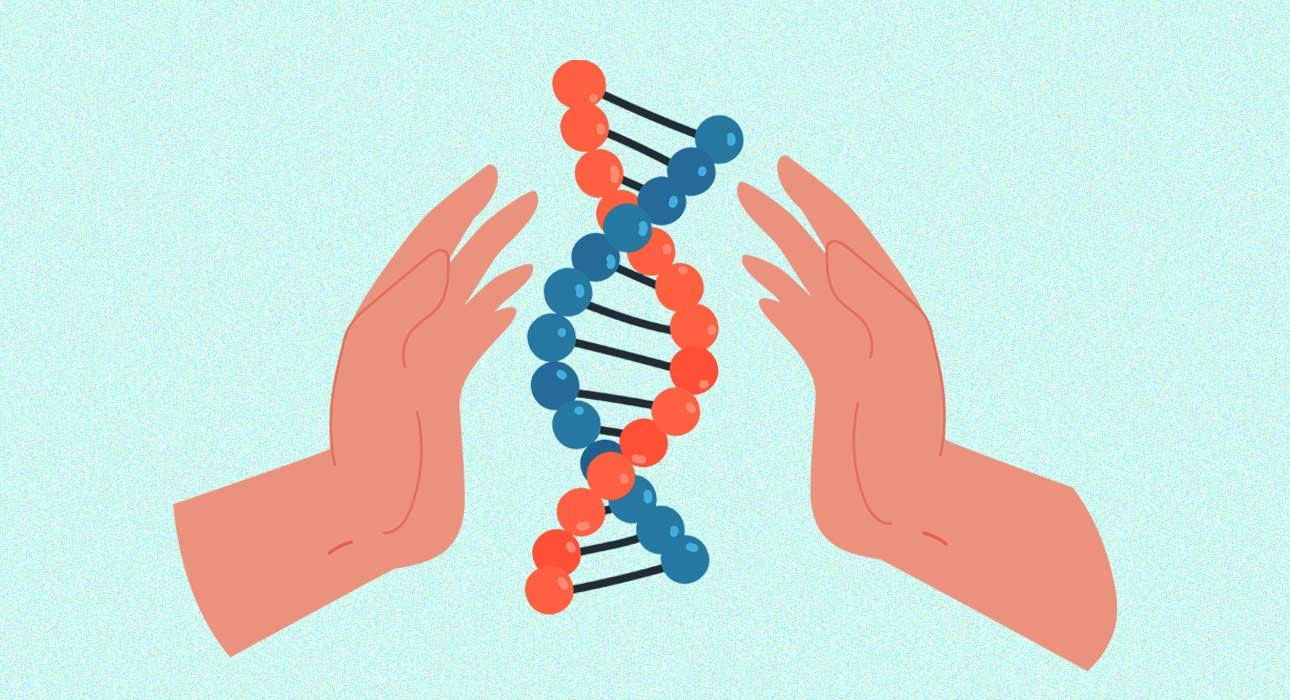Have you ever wondered why some people exude peace and others readily succumb to stress, or why a connection with some is immediate, while with others, not? Such fascinating variety in human experience is, in large measure, due to our genes. Within the intricate confines of every cell, these small bits of DNA have extremely powerful influences on our identity, our behaviour, and how we interact with others. Our genetic makeup, however, plays a central part in deciding fundamental aspects of our lives, including:
- Personality: The innate characteristics that define our nature.
- Regulation of emotions: Our capacity to control and outwardly express emotion.
- Quirks of character: The unique behaviour, however, that makes us different.
There is empirical support for this genetic influence. For instance, the SLC6A4 gene, which controls serotonin—a neurochemical involved in mood—has been linked to variance in neuroticism (worrying tendency) and agreeableness (cooperation tendency). Both of these traits have potent influences on relationship satisfaction and longevity (Eskandar, 2025). Also, our attachment styles, which control how we bond, appear to have a genetic component.
Research has proven that subtle changes in the OXTR gene, linked to oxytocin, a “love hormone”, it is commonly known to be related to our ability to form social bonds. Genes certainly play a role, but their influence is always in dynamic interaction with the world around us, working together to create the complex fabric of human behaviour (Eskandar, 2025).
Read More: How Does a Child Develop Attachment Style?
The Dynamic Interplay of DNA and Environment
An extensive comprehension of human behaviour requires acknowledging the ongoing interaction of our hereditary blueprint and environmental exposures. Our genome gives us the initial template, but life experience—ranging from personal interactions, social connections, and cultural settings—shapes how these inherited tendencies express themselves. This adaptive interplay explains the extensive behavioural variations noted even in individuals with very similar gene codes, like siblings shared by the same parents.
Studies consistently demonstrate how conditions in the environment can exert a strong influence on gene expression to produce divergent behavioural consequences based on the living situation of a person (Human behaviour genetics, 2025). Such a refined interconnection helps to explain complex human traits like aggression and sympathy based on the role played by both genetic and experiential factors in a person’s development (Lohakare, 2023).
Read More: How Parental Genes Create Environments That Influence Child Development
Cracking the Body’s Genetic Code
1. Genes, Genomes, and Alleles: Key Terms
To grasp the genetic foundations of behaviour, there needs to be some basic familiarity with key terms:
- Genes: These are hereditary building blocks made up of particular DNA sequences. Genes are analogous to “instruction guides” for producing proteins, which in turn affect nearly all biological processes and traits, from physical characteristics like hair colour to intricate brain function.
- Alleles: Genes can exist in different forms, which are called alleles. These allelic variations are responsible for differences in an organism’s phenotype, or those traits that can be observed.
- Genomic: The entire collection of an organism’s genes is its genome. Apart from protein-coding parts, the genome also has “non-coding regions” that act as switches and control when genes are activated or deactivated. These subtle genetic variations are crucial to accounting for differences in behaviour, from intelligence to inclinations toward specific behaviour (3: Evolution, Genes, and Behaviour Biopsychology, 2022). Knowing about human behaviour requires a holistic picture that integrates genetic knowledge with the environment.
Read More: The Role of Genetics in Mental Health
2. Quantifying Genetic Influence Through Heritability
Heritability is a statistical measure that estimates the proportion of variation in a particular trait within a population attributable to genetic differences. Expressed as a percentage, heritability indicates the extent to which genetic factors cause people to differ from one another. To illustrate, if IQ has 50% heritability, approximately half of the IQ differences within a population are attributable to genetic differences, for example.
Twin research is valuable as far as estimating heritability and providing robust evidence of the large genetic contribution to most behavioural traits is concerned. Though these studies highlight the large role of genes in shaping differences among individuals, they also point towards the stark role of the environment, which can modulate and amplify genetic susceptibility over time (Plomin et al., 2016). The interaction between life experiences and genetics is continuously ongoing in shaping a person.
Read More: Genetic Insights into Schizophrenia from Rare Variants
The Study of Epigenetics
1. Processes of Epigenetic Modification
Epigenetics is the wonderfully fascinating process by which environmental factors influence gene expression without altering the underlying DNA code. The DNA code never changes, but the way it is “read” and interpreted by the cell may be modified. The epigenome can be considered as a layer of chemical “tags” or “notes” added onto the genetic material. These changes include:
- DNA methylation: The addition of a chemical tag (methyl group) to DNA.
- Histone modification: Changes to the proteins (histones) to which DNA is wrapped.
They are molecular switches of genes on/off. Their formation is decided by a complex combination of factors, including dietary habits, degrees of stress, and clusters of life experiences. For instance, traumatic life experiences can form lasting changes in gene expression that persist over an individual’s lifespan (BURT & SIMONS, 2014). This sophisticated balance between genetic makeup and environmental factors is evidence of the intricacy of human biology and behaviour.
Read More: Emotions: Play of Environment and Biology
2. Environmental Modulation of Gene Expression
Our environment significantly affects the way our genes express themselves via epigenetic mechanisms. Such changes modify the activity of genes without altering the DNA sequence. Social interactions, diet, and stress can induce epigenetic modification, including histone modification and DNA methylation, that decides whether a gene is turned on or off.
For example, a stressful environment can trigger genetic susceptibilities, increasing the likelihood of persons with specific genetic variants developing aggression or anxiety in reaction to harsh conditions (Palumbo et al., 2018). Conversely, a supportive environment can promote adaptive behaviours and emotional health by promoting positive patterns of gene expression (Eskandar, 2025). Our life experiences literally leave an irreparable mark on our genetic code, illustrating the strong influence of nurture over nature.
Read More: Mindset and Gene Expression
3. Real-World Effects of Epigenetic Modifications
Epigenetic changes are highly regulated by lived experiences and significantly contribute to the shaping of behaviour by controlling gene expression without modifying the DNA code. For instance, extreme stress in early life can yield long-lasting changes in DNA methylation that target selectively genes related to emotional regulation and stress response.
Studies consistently demonstrate that adverse childhood experiences are capable of inducing enduring epigenetic alterations in genes responsible for anxiety and depression. Conversely, nurturing environments, characterised by benevolent social interactions and cognitively demanding tasks, are capable of inducing positive epigenetic effects, which lead to improved behavioural outcomes. Research even suggests that nurturing environments can reverse such damaging epigenetic markers responsible for maladaptive behaviour (Pang et al., 2019), reflecting the dynamic and changeable interplay between environmental factors and gene operations.
The Genetic Basis of Human Characteristics
1. Aggression
Aggression is a complex trait with influences from both genes and the environment. Heredity accounts for approximately 50% of the differences in aggressive behaviour (Tuvblad & Baker, 2011). Genetic influences on neurochemical systems of the brain are strongly linked with aggressive tendency in individuals, particularly under conditions of stress. Serotonin pathway genes and genes that regulate hormones are specifically crucial to the modulation of aggression (Tuvblad & Baker, 2011).
Nevertheless, challenging early environments can exaggerate these genetic tendencies, giving rise to epigenetic alterations that influence gene expression and, ultimately, violent behaviours (Palumbo et al., 2018). This constant interaction is what accounts for the reality that two individuals possessing identical genetic blueprints might have very distinct violence levels due to their respective dissimilar life histories—a prototypical instance of nature vs. nurture.
2. Intelligence
The longstanding debate regarding the origin of intelligence—nature or nurture—is resolved by a synergistic view: both are essential. Studies indicate that genetics accounts for roughly 50% of IQ score differences. Interestingly, heritability rates for intelligence increase with age, from approximately 20% in infancy to nearly 80% in adulthood (McLeod & Guy-Evans, 2024).
Environmental factors do have an irreversibly significant input. Most crucial are the determinants of quality of life and education. Shared environment is more influential during early development, but individual experiences become progressively more significant as people mature. The Flynn effect, the term for the phenomenon of rising average IQ scores from one generation to the next across the globe, is the best example of the way improved conditions in society can boost mental capacity, demonstrating the complex but lovely combination of genetic and environmental factors.
3. Empathy
Empathy, a key component for bonding between people, is influenced by genetics as well as society. Empirical data are starting to indicate that genetic differences in the oxytocin receptor gene (OXTR) can amplify empathic responses and emotional bonding. Individuals having some variants of genes could have enhanced empathic responses and develop deeper social connections (Eskandar, 2025).
Above all, empathy is not genetically determined. Social learning, including parent training and peer relationships, is indispensable. The development of empathy is thus a steady two-way interplay between inherited tendencies and learning through experience.
4. Resilience
Resilience, the amazing capacity to rebound and adapt in the face of adversity, is encoded by a combination of environmental and genetic factors. Certain genetic variations can provide better resilience under stress, particularly those that affect cortisol (stress hormone) management. Being in a supportive environment is also vital for developing resilience, no matter what an individual’s genetic profile may be.
Supportive relationships act as an effective protective shield, while adverse and stressful conditions tend to enhance vulnerabilities, especially among individuals with poorer genetic traits. It is established that the genetic composition of a child interacts with environmental factors, such as family dynamics and socioeconomic status, to influence their resilience (Tuvblad & Baker, 2011). This supports the extremely complex nature of human behaviour and the requirement to consider both genetic and environmental variables.
Read More: Importance of Emotional Vulnerability in Relationships
Sibling Study Findings: Twin and Adoption Studies
1. Methodological Findings from Twin Studies
Twin studies are the backbone of behavioural genetics, establishing a unique template for disentangling genetic and environmental influences on behaviour. This is done through comparing:
- Monozygotic (MZ) twins: Identical twins, who are basically genetic clones of one another.
- Dizygotic (DZ) twins: Fraternal twins, who share around 50% of their genes, similar to regular siblings.
By analysing behavioural concordance among twin pairs, researchers can learn a great deal about heritability. Far greater behavioural concordance among identical twins definitely points towards a genetic influence. Conversely, unaccounted-for similarity among fraternal twins suggests the role of shared environment. Furthermore, differences observed within sets of identical twin pairs are used to explain the influence of non-shared environmental experiences. Numerous twin studies have yielded influential findings regarding the genetic root of behavioural traits.
2. Twin Research: Most Significant Findings
Twin research is fundamental to the investigation of heritability across a wide selection of attributes. The contrast between MZ twins, who are virtually genetic duplicates, and DZ twins, who share about 50% similarity, enables scientists to determine the contribution of genetic factors towards the determination of behaviour. Greater similarity of identical twins is a clear indicator of genetic contribution. For instance, certain behavioural characteristics like empathy and hyperactivity always exhibit clear hereditary patterns in twins.
Scores from the Twins in Early Development Study (TEDS) indicate that heritability estimates for most psychological traits cluster around 50% (Saudino, 2005). This robust finding indicates a significant genetic contribution to inter-individual differences in human behaviours.
3. Twin Studies and the Significance of Heritability
Heritability is crucial to be understood to address the intricate gene-environment ballet. Twin studies also clearly indicate that identical (MZ) twins are more similar in their behaviour than fraternal (DZ) twins (Human behaviour genetics, 2025), thereby confirming the preponderant role of genetics. Adoption studies also explain this relationship by examining people who were raised apart from their own groups, and they provide more evidence of the balanced effect of genetic and environmental factors.
Research continually demonstrates that genetic influences shape a large number of psychological traits, and hence it is assumed that behaviours are polygenic, with multiple genes contributing to them (Hayden & Sheikh, 2017). This overwhelming evidence makes it necessary to integrate genetic information for a fuller understanding of human behaviour.
Adopted Lives: Further Evidence in Favour of the Nature-Nurture Equation
1. Adoption Studies
Adoption studies are another powerful methodological tool in behavioural genetics, providing a unique window to examine how genetic and environmental factors control human behaviour. The experiment is simple yet powerful: adopted children are reared in families with whom they have no genes. This setup is ideal for disentangling and testing the effects of nature and nurture.
A comparison of the adopted children’s behaviour and psychological traits to those of their adoptive parents and their biological parents allows researchers to assess the degree of genetic influence. It has been a recurring finding that adopted children are more similar to their biological parents in some traits, for instance, intelligence and aggression (McLeod & Guy-Evans, 2024). This demonstrates in a significant way that genes form a foundation of our behaviours.
The results of adoption studies are definitive in establishing that both genetic and environmental influences contribute to the behavioural traits like aggression and intelligence. One highly influential meta-analysis set up that genetic effects accounted for approximately 41% of the variance of antisocial behaviour, and shared environment for only 16% (Rhee & Waldman, 2002).
2. Twin vs. Adoptee Studies: A Comparative Perspective
Twin and adoption studies both give profound insights into the genetic and environmental causes of human behaviour. Identical (MZ) twins, who share nearly 100% of their genes, and fraternal (DZ) twins, who share approximately 50%, give scientists the tools to estimate heritability by examining resemblance in traits. If identical twins exhibit the same behaviour much more often, this is a sign of strong genetic influence.
Research (Hayden & Sheikh, 2017) shows that psychological variables such as intelligence and aggression have strong genetic influences. The designs used in these studies complement one another to provide insight into how complicated the interaction of nature and nurture is when it comes to the development of behaviour.
Read More: Theories of Aggression: Understanding the Roots of Violent Behaviour
Practical Implications: What This Means for You
1. Mental Health Treatment: Towards Personalised Approaches
Understandings of the genetic underpinnings of mental health have the potential to transform treatment. Genes play a role in susceptibility to any mental disorder and can affect how treatment works. Identifying specific genetic risk factors can set the stage for individualised treatment protocols based on one’s unique response to medications. According to Eskandar (2025), matching genetic data with treatments has the potential to develop highly specific strategies, tailoring therapy to an individual’s genetics.
Moreover, research (Baker, 2007) brings to light the significance of environmental factors interacting with genes. Effective mental health treatment demands an integrated approach that merges biological insight with non-judgmental therapy, taking both nature and nurture into account for effective recovery.
Read More: Comprehensive Insights into Mental Health & Mental Disorders
2. Education: Personalising Learning for Greater Success
This can be drawn upon to enhance educational practices considerably, crafting customised pedagogical strategies focused on specific strengths and weaknesses. Identification of the genetic influence on certain learning abilities allows teaching professionals to make their style more personalised. For instance, if a student has a predisposition towards visual instruction, combining visual resources intensely may prove highly beneficial.
Genetics can also inform interventions for struggling learners, providing specific interventions. An understanding of cognitive traits during teacher training helps educators embrace many learning styles. As Eskandar (2025) posits, the interface between genetics and education can result in innovative solutions that maximise learning motivation and optimise academic outcomes, finally making learning more efficient for everyone.
3. Policy: Informing Behavioural Interventions
Strategies to address behavioural challenges need to integrate behavioural genetics findings, considering the complex interplay between genetic predispositions and environment. Strategies may be directed at early intervention for risk groups through behaviour genetics program refinement in mental health and education interventions. As an example, Baker (2007) outlines how understanding the influence of parental contribution on child development can improve the prevention of family-based mental disorders.
In addition, recognising genetic factors affecting characteristics such as aggression or resilience may assist in the customisation of public health initiatives. Policymakers, however, have the important responsibility of ensuring these practices are implemented ethically, protecting privacy, and avoiding stigmatisation linked to genetic details.
Concluding Insights and Future Directions
1. Key Takeaways from Behavioural Genetics
Our genes play a significant role in influencing a broad spectrum of human conduct, including aggression, intelligence, empathy, and resilience. There are indications that neuroticism may be heritable and thus may explain unstable relationships, whereas agreeableness is associated with greater relationship satisfaction (Eskandar, 2025). Aggression research squarely indicates consistent findings of a complicated interplay between genetic elements and environmental contexts, indicating a shared genetic origin for externalising behaviour (Tuvblad & Baker, 2011).
Furthermore, temperament studies reveal that emotional response can predict behaviour problems like anxiety and aggression, which proves the strong impact of general genetic factors over environment (Saudino, 2005). Overall, these points of evidence reveal the intricate interlinks of our genes and our behaviour in different situations, and expose the profound and complicated truth about human nature.
Read More: The link between Personality Traits and Relationship Satisfaction
2. Future Directions in Behavioural Genetics Research
Future studies on human behaviour genetics should, as their number-one priority, focus on coming together with new methods, with the main focus being laid directly on gene-environment interactions. To quote Koyama et al. (2024), diverse research methods—such as epigenetic studies and longitudinal research (tracking individuals over time)—must be brought together to finish filling out the picture of how heredity and environment shape behaviour. Eskandar (2025) also advances the role of epigenetics in relationship processes, with suggested future directions exploring alterations in gene expression over time.
Genome-wide association studies (GWAS) will be particularly significant in prioritising due to their capacity to identify genetic markers for important behavioural traits and enhancing prediction models with polygenic risk scores. Bigger population sizes are also necessary for yielding more generalizable and broader-ranging findings. The field is ever-evolving, with discoveries that will continue to shed light on the mysteries of human behaviour.
3. The Concept of “Hardwired” Emotions Revisited
The “hardwired” theory of emotion points to the ongoing dance between our genes and our emotional responses. Genetic predispositions do, indeed, influence our reaction to stimuli, deciding attachment orientations and emotional regulation. While some have called for strong genetic determination of behaviour, there is an important and undeniable contribution of the environment.
Early experience strongly determines the expression of genetic propensities in such behaviours as resilience, aggression, and empathy. As Eskandar (2025) asserts, this interaction is evidence that emotional reactions do have a biological basis but are also strongly shaped by lived experience. Understanding this dynamic interaction takes us above the reductionist “nature versus nurture” viewpoint, depicting human behaviour as an abundance of rich, spectacular, and dynamic processes.
FAQs
1. Do my genes completely control my behaviour?
No way! Genes provide a blueprint, but your life experiences and environment constantly interact with them, shaping who you become. It’s a dynamic dance.
2. What is epigenetics?
Epigenetics shows how your environment changes gene activity—turning genes on or off—without altering your DNA sequence. Your life literally leaves its mark.
3. Does heritability mean a trait is purely genetic?
No. Heritability estimates the variation in a trait due to genes within a population, not that it’s solely genetic. The environment always plays a role.
4. Can genes influence traits like aggression or empathy?
Yes, genetic variations are linked to traits like aggression and empathy. However, environmental factors and life experiences heavily modify how these traits manifest.
5. How do twin and adoption studies help understand genes and behaviour?
They compare people with varying genetic and environmental overlaps. This helps researchers separate and understand the distinct influences of nature and nurture
References +
Catherine Tuvblad, Laura A Baker. (2011). Human Aggression Across the Lifespan: Genetic Propensities and Environmental Moderators. https://pmc.ncbi.nlm.nih.gov/articles/PMC3696520/
Kirolos Eskandar. (2025). Genetic contributions to the stability and satisfaction in Sexual Relationships. https://www.sciencedirect.com/science/article/pii/S269994042500044X
Sangharsh Lohakare. (2023). How Does Genetics Influence Our Behaviour?. https://www.technologynetworks.com/genomics/news/how-does-genetics-influence-our-behaviour-375513
Human behaviour genetics. (2025). https://en.wikipedia.org/wiki/Human_behaviour_genetics
Elizabeth P. Hayden, Haroon I. Sheikh. (2017). The SAGE Encyclopedia of Abnormal and Clinical Psychology. https://sk.sagepub.com/ency/edvol/the-sage-encyclopedia-of-abnormal-and-clinical-psychology/chpt/genes
Kimberly J Saudino. (2005). Journal of developmental and behavioural paediatrics. https://pmc.ncbi.nlm.nih.gov/articles/PMC1188235/
Jill Portnoy, AnaCristina Bedoya. (2023). Biosocial Criminology: History, Theory, Research Evidence, and Policy. https://www.tandfonline.com/doi/full/10.1080/15564886.2022.2133035
3: Evolution, Genes, and Behaviour Biopsychology (OERI) – DRAFT for Review. (2022). https://socialsci.libretexts.org/Bookshelves/Psychology/Biological_Psychology/Biopsychology_(OERI)_-_DRAFT_for_Review/03%3A_Evolution_Genes_and_Behaviour/3.09%3A_Genes_and_Behaviour
Robert Plomin, John C DeFries, Valerie S Knopik, Jenae M Neiderhiser. (2016). Perspectives on Psychological Science. https://pmc.ncbi.nlm.nih.gov/articles/PMC4739500/
Saul McLeod. PhD, Olivia Guy-Evans. MSc. (2024). Nature vs. Nurture Debate In Psychology. https://www.simplypsychology.org/naturevsnurture.html
Emiko Koyama, Tuana Kant, Atsushi Takata, James L. Kennedy, and Clement C. Zai. (2024). Genetics of child aggression, a systematic review. https://www.nature.com/articles/s41398-024-02870-7
Palumbo. Sara, Pellegrini. Silvia, Iofrida. Caterina, Mariotti. Veronica. (2018). Frontiers | Genes and Aggressive Behaviour: Epigenetic Mechanisms Underlying Individual Susceptibility to Aversive Environments. https://www.frontiersin.org/journals/behavioural-neuroscience/articles/10.3389/fnbeh.2018.00117/full
You-Yuan Pang, Rita Jui-Hsien Lu, Pao-Yang Chen. (2019). Behavioural Epigenetics: Perspectives Based on Experience-Dependent Epigenetic Inheritance. https://pmc.ncbi.nlm.nih.gov/articles/PMC8594690/
Emily A. Willoughby, Matt McGue, William G. Iacono, James J. Lee. (2021). Genetic and environmental contributions to IQ in adoptive and biological families with 30-year-old offspring. https://www.sciencedirect.com/science/article/abs/pii/S0160289621000635
Laura A. Baker. (2007). THE BIOLOGY OF RELATIONSHIPS: WHAT BEHAVIOURAL GENETICS TELLS US ABOUT INTERACTIONS AMONG FAMILY MEMBERS. https://pmc.ncbi.nlm.nih.gov/articles/PMC4685725/
CALLIE H. BURT, RONALD L. SIMONS. (2014). PULLING BACK THE CURTAIN ON HERITABILITY STUDIES: BIOSOCIAL CRIMINOLOGY IN THE POSTGENOMIC ERA. https://www.researchgate.net/publication/260833911_Pulling_Back_the_Curtain_on_Heritability_Studies_Biosocial_Criminology_in_the_Postgenomic_Era













Leave feedback about this